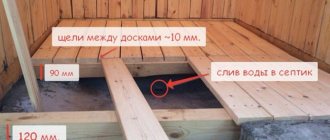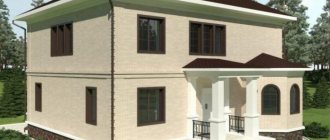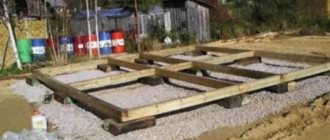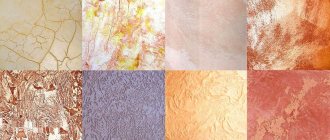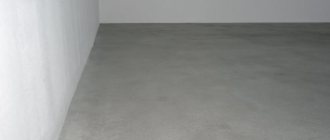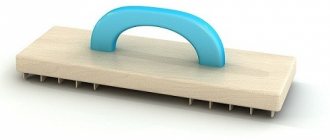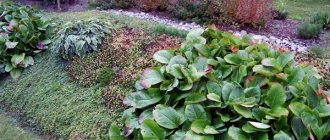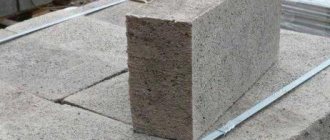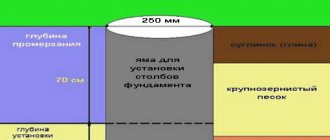specializes in the installation of concrete coatings based on concrete. Our services include marble-concrete flooring, made using traditional technologies. These coatings are considered elite and will be especially appropriate in expensive cottages and significant public spaces (hotels, boutiques, offices of large companies). The color palette, as well as the possibility of choosing design solutions, is not limited in this case. We create a project and select materials exclusively for your order, individually. Marble flooring on a concrete or polymer base retains the splendor of natural stone, but remains strong, wear-resistant and durable.
I want to see more worksAdvantages of marble chip floors
Marble flooring looks great in public and residential areas, and also has the following advantages:
- durability and strength;
- hypoallergenic, hygienic, environmentally friendly;
- moisture resistance;
- chemical resistance;
- original appearance;
- sparks are not generated from marble chips, which makes it possible to use such a coating in rooms with high fire safety requirements;
- at home, such decorative finishes can be combined with heated floors
The white marble floor looks impressive, luxurious and festive. This is an excellent decorative finish that looks good in all “home” interiors without exception. So, this could be a good solution for the living room. Gray marble is denser than white marble and is more resistant to wear due to the impurities it contains. Therefore, it is used in offices and in walk-through areas. You can also order colored marble flooring, plain or mixed (red, green, black, blue).
When choosing floors made from marble chips, you can choose not only the shade, but also the texture of the coating. We provide sanded, glossy or non-slip coatings.
Preparing the base of a concrete mosaic floor.
The basis for a future floor made of marble chips can be a reinforced concrete slab of interfloor covering, a concrete underlying layer, or cement-sand screeds.
You need to make sure that the base itself is strong enough and rigid, with a grooved, corrugated surface for better adhesion to future self-leveling floors.
If there are cracks, chips or various potholes, they are embroidered, primed and sealed using repair compounds. In addition, it is necessary to seal all holes near the pipeline and other technological equipment with special care, since sealing them in a ready-made concrete mosaic coating is unacceptable.
The horizontalness of the base or its slope must fully comply with all standards. Defects in the base cannot be corrected using the mosaic layer, since its thickness, as mentioned above, is only fifteen to twenty centimeters.
The base must be rinsed with water before proceeding directly to installation.
Price
| Floors with marble chips | |
| Minimum order for marble floors – RUR 80,000 | |
| industrial marble floor 30mm thick | from 2.300r/sq.m. |
| decorative floor with marble chips | from 6,000r/sq.m. |
| steps with marble chips | from 16,000r/sq.m. |
The price list shows the price per m2 of marble flooring without complex artistic solutions (monolith, in one color). The cost of decor is discussed additionally. Also, the price depends on the coverage area, configuration and purpose of the room. The materials used as a base are also important - it can be concrete or a polymer composition.
We provide discounts for large projects.
Marble chips
Marble chips or mosaic floors are a material that is made from granules of defective marble, which are held together with transparent glue.
To make the crumbs have bright colors, epoxy resins are added to it and due to this, its price increases.
Marble chips are used to decorate handrails, window sills, produce soil for aquarium farming, make the basis for flower beds, and monuments. Sidewalks are made from it.
This material is divided according to size. It can be of large, medium and small fractions.
What are the advantages of marble chips:
- Strength.
- Sands and polishes well.
- Elasticity due to the presence of glue in the composition. This prevents scratches from appearing on the surface.
- Environmentally friendly.
Marble flooring technology
Before creating such a coating, we must carry out comprehensive preparation of the base and leveling. If necessary, make markings for the drawing. We produce marble-effect self-leveling floors using a multi-stage technology:
- We prepare the mosaic composition and fill it according to the completed markings;
- Carefully level the composition;
- We grind the poured floor in 3 stages, changing the degree of grain of the grinding elements, which allows us to reveal the beautiful texture of the marble
Concrete floors with marble chips require the preparation of a special solution. Marble grains ranging in size from 15 to 2.5 mm are selected as the main material in almost equal proportions, which allows you to obtain an original, uniform pattern with beautiful reflections. The binder can be gray or white Portland cement of grades M400 and higher. In this case, the bottom layer is created from low-grade cement without additives. The solution is carefully compacted and leveled, and after setting (but before hardening) the mosaic mixture is poured. We also perform multi-stage grinding: rough grinding allows us to reveal the texture, and subsequent operations produce a surface with a beautiful gloss. After polishing, the concrete floor can be coated with a hardening impregnation or varnish.
Preparing the solution and pouring the mosaic floor
The entire process of creating a floor from marble chips is divided into two stages. First of all, prepare and pour the preparatory layer, to create which you will need to prepare a fairly liquid cement-sand mixture and pour it in a thin layer over the entire surface of the floor, moistened with water. For more information on how marble chip floors are installed, watch this video:
For convenience and reliability, distribute the solution with a spoon or a broom (depending on the size of the card).
The thicker cement mortar is carefully laid out on the cards, leveling it with a wooden spoon (trowel). The surface should be flat and smooth, and the thickness of this layer will be 20 cm.
Now they begin to prepare the second batch of solution. Marble chips cannot be added to the composition in dry form. The dust present on its surface will subsequently cause the loss of small fractions and the formation of voids on the floor surface, so all components are thoroughly washed with clean (without silt and dirt) water.
For a durable coating, use cement grade M500
The number of components required to prepare the solution depends on the required coating strength.
To achieve the maximum level, you will need cement grade M500 and clean sifted sand, taken in equal parts, as well as marble chips, the amount of which is twice the amount of cement.
For every kilogram of cement used, 0.5 liters of water will be required to ensure the solution reaches the desired consistency.
The quality of the solution is affected by the introduction of dye and whitener into its composition, so it is necessary to carefully ensure that the amount of dye is no more than 15% of the total amount of cement.
The mixture should be laid out on the cards after the first layer has set, but before it has completely hardened. In accordance with the project, the composition is laid out in the cards with the addition of crumbs of the desired color. For more information about installation, watch this video:
Tamp carefully but thoroughly, making sure that the established level is not violated. After filling all areas of the mosaic, the surface is left untouched for a week.
Equipment and materials used
To create mosaic floors, we use products from well-known brands, elite finishing materials from Utlratop, Bautech, Ardex Pandomo. We can use standard gray concrete or white cement as a base, as well as filler – stone chips of a certain color and fraction.
Additionally, we can use polyurethane dedusting impregnations, polymer additives for cement, epoxy or polyurethane binders to fix the filler. Ready-made mixtures can be poured to a thickness of 5-30 mm. After polishing, they are opened with wax or oil.
Required tools and materials
What tools and materials may be required to lay marble floors:
- Level for precise positioning of slabs.
- A dry cloth to remove excess glue or cement.
- Container for mixing solutions.
- Of the materials used, you only need a cement mixture or glue.
- Two types of spatulas. One (toothed) for applying the mixture to the tiles and one (rubber) for grouting the joints.
- Crosses for creating smooth joints between tiles.
- Manual tile cutter.
- Means for protecting mucous membranes and skin.
- Tape measure, pencil or marker.
- Mallet.
- Metal brush.
- Grinding equipment.
- Bulgarian.
How it's done
Having prepared the base in the form of a screed or a base filled with another solution, you can proceed to applying the future design on them. Typically, parts of the design are separated by brass or metal strips. If the pattern is continuous, without dividers, then use temporary plastic strips to prevent the colors from mixing during the drying stage - then they are removed, and the gaps are filled with a small amount of tinted solution.
To ensure that your floors made of marble chips are level, you need to install construction beacons at a level. If markings are used, then metal separators of the fragments of the pattern can immediately act as beacons. For a continuous coating in one color, construction beacons are used. They are attached to ordinary cement mortar.
Next begins pouring the color mixture itself. The solution must be thoroughly compacted and all air expelled from it. If laitance appears on the surface, it should be removed immediately with a spatula. After one of the floor fragments is completely formed, it is leveled and smoothed. Temporary beacons, after filling the entire surface, are removed and the resulting gaps in the canvas are filled with solution. This must be done very carefully so as not to spoil the entire drawing.
While the poured floor hardens, it must be covered with film and moistened regularly to avoid cracking. After a week, if everything is done according to the rules, the floor will dry and the next stage begins - sanding. First, it goes rough - sand is poured onto the surface and the entire area is processed with a grinder. They remove the sand, look at the result and repair existing defects if they are found. Using the average grain size of the tool, everything is processed in the second stage. The final step is polishing with a felt nozzle and a special paste.
Peculiarities
The technology itself by which mosaic floors are created from marble chips is very simple. Two layers are made: one will be the base and will act as a leveling surface, and the second will be the finishing layer and at the stage of its creation it will no longer be possible to correct any flaws in the work. The first one is usually a standard screed made of concrete or a special mortar. The second layer is a mixture with the addition of finely crushed marble, which, in fact, gives the coating the desired appearance.
Preparing a solution that will be used to fill the top layer is not as difficult as some might think. The proportions of the composition are as follows:
- One part of cement marked M400.
- Marble particles of large fractions - one part.
- Medium size additive - one part.
- The fine fraction is also one part.
An exception will be some types of floor colors - will you be making a colored floor? For a green or white main color and black inclusions, you will have to take one and a half parts of white cement of the same brand. At the same time, it is important to correctly add the dye to the composition in order to ultimately get what you need. It must be calculated as a percentage relative to the amount of cement:
- A black and white floor with white dots is made with simple potassium permanganate, to which you need to add twelve and a half percent.
- Ten percent of red lead is added when they want to get a red floor with white splashes.
- A pink scattering on the same red background - you already need eight percent red lead.
- If the additives are red, and the background itself is brown, then you need to add five percent of the same dye.
- The floor is a complex green color with a white filler created with chromium oxide - as much as 15% percent of white cement and two parts of large stone.
It is not difficult to mix the mixture to make colored mosaic floors from marble chips: mix everything dry very thoroughly, dilute the required amount of dye in water and gradually add tinted water to the solution. You need to calculate everything so that after the colored water runs out, add a little more clean water.
Objects for creating a floor with marble chips
Industrial floors are a flexible concept. In fact, such floors can become surfaces in institutions of various types. These include the following premises:
- warehouses
- garages
- production workshops
- car washes
- foyers of administrative and educational buildings, etc.
In fact, the production of industrial floors is based on the use of concrete with the addition of pigments to give the surface the required color and marble chips, which act as both a plasticizer to give the mixture elasticity and a filler to increase the degree of solidity.


